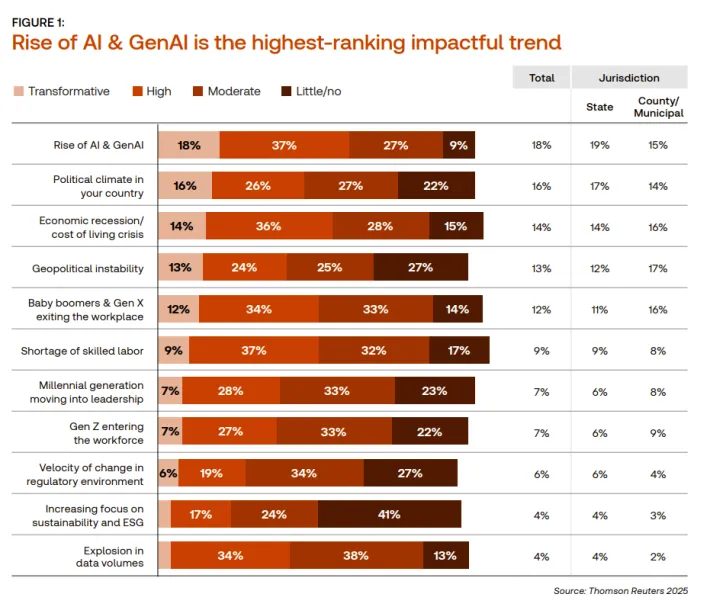Preparing for future workforce needs
Staffing shortages, rising caseloads, and court delays are pressing challenges for state courts today. At the same time, emerging technologies — particularly artificial intelligence (AI) — offer new opportunities to ease workloads and better serve the public.
During "Exploring the Effects of AI and Generational Shifts in the Workforce," experts Jen Leonard, David Slayton, and Chief Administrative Judge Joseph Zayas discuss how courts are adapting to challenges while highlighting key trends, real-world examples, and practical steps forward.
What the data tells us
Our panelists see two trends shaping the future of courts:
- The rise of generative AI
- Significant shifts in the workforce, including shortages, retirements, and new expectations from younger generations

These trends, along with others outlined in Figure 1, are converging at a critical time — forcing courts to rethink how they deliver services, manage caseloads, and support their teams.
AI is here – and court leaders are paying attention
According to "Staffing, Operations and Technology: A 2025 survey of State Courts" from the Thomson Reuters Institute, survey results show that 91% of respondents expect AI to have at least a moderate impact on court operations, with many anticipating it will be highly or even transformatively influential. Only 9% said it wouldn't have an impact at all.
While many court leaders and staff see AI's potential, most are proceeding with caution. Their top concerns include:
- Cybersecurity and data privacy
- Misinformation and bias in AI-generated content
- Overreliance on automated tools instead of human judgment
Despite these concerns, courts aren't shying away from AI — they're actively looking for the right tools, training, and policies to implement it responsibly and effectively.
"Only 25% of court systems have offered AI training. The best way to address concerns is through education and exposure — even if it's just getting familiar with how the technology works. Court staff must take that step to embrace AI responsibly and confidently, so it can support justice rather than hinder it."
— Chief Administrative Judge Joseph Zayas, New York State Unified Court System
Staffing shortages straining court operations
More than 70% of survey respondents reported staffing shortages in the last year, and 61% expect shortages to continue. These gaps are hitting every level — from courtroom clerks to interpreters to court reporters.
At the same time:
- 45% of survey respondents report growing caseloads and increasing case complexity
- 20% report delays in more than 30% of cases
- Over half say they're working more than 45 hours a week and still can't keep up
"I don't think it will surprise anyone familiar with the courts that resources are consistently stretched thin. I've said before, there's probably not a court anywhere — in this country or the world — that believes it has too much funding or staff, or too little work to do. What we're seeing now are staffing shortages, with many court employees working extra hours and feeling overwhelmed."
— David Slayton, executive officer/clerk of court, Superior Court of Los Angeles County
Many courts are also experiencing a wave of retirements among experienced staff — those who hold deep institutional knowledge. Replacing them is challenging due to limited talent pipelines, public sector pay limitations, and competition from the private sector.
Despite these pressures, only 1% of survey respondents identified hiring as a top operational priority, revealing a disconnect between workforce needs and resource planning.
How courts are adapting
To ease pressure from staffing shortages and rising caseloads, some courts are turning to AI tools that reduce manual workload and support day-to-day operations.
Real-world applications include:
- Automating document summarization and redaction
- Streamlining scheduling and case processing
- Providing self-service tools for the public, such as jury duty rescheduling
- Translating and transcribing virtual hearings in real time
But successful innovation isn't just about adopting technology — it's also about preparing the people who use it. As Gen Z and millennials enter the court workforce and baby boomers and Gen X employees retire, courts face a widening gap in institutional knowledge and tech readiness.
While younger staff may be comfortable with digital tools, they still need guidance in areas like court culture, critical thinking, and ethical use of AI. Likewise, experienced staff often need support and training to confidently use new systems. Cross-generational learning, inclusive onboarding, and continuing education are essential for future-ready court teams.
"The myth of a fully AI-literate generation is just that — a myth. Everyone needs hands-on training and space to learn ... We're in the first inning of a long game. Now is the time to experiment, learn, and lead with intention."
— Jen Leonard, founder and CEO, Creative Lawyers
Preparing for a human-first, AI-forward future
AI is not about flashy technology — it's about solving real problems in ways that support people. When used responsibly, AI can help courts reduce backlogs, assist self-represented litigants, and give staff more time to focus on meaningful work.
But courts must proceed with care. AI should never replace human decision-making. Instead, it should be guided by strong values: fairness, accuracy, transparency, and impartiality. Protecting data security and recognizing potential bias are essential to maintaining public trust.
"Judicial integrity means AI can help — but not decide. Human oversight is critical."
Joseph Zayas
Chief Administrative Judge, New York State Unified Court System

Four steps toward AI confidence
Train everyone on AI
Offer foundational training to judges, clerks, and public-facing staff. Help them understand what AI is — and isn't.
Reevaluate workflows
Don't just add new tasks. Identify what can be paused, simplified, or automated.
Celebrate small wins
Encourage experimentation and share early success stories to build confidence.
Create an AI policy
Set clear guidelines. California now requires each court to adopt an AI use policy — other states may soon follow.

Explore more AI resources
Need help getting started?
We provide support, training, and tools to help courts adapt to a changing future. Let's shape the future of justice — together.
TRI/NCSC AI Policy Consortium for Law & Courts
An intensive examination of the impact of technologies such as generative AI (GenAI), large language models, and other emerging, and yet-to-be developed tools.
Explore more
Leveraging AI to reshape the future of courts
Find out how our experts can help your court leverage the power of AI for use in document processing, data analytics, chatbots, litigant portals, and more.
AI & the courts: Judicial and legal ethics issues
The article explores the intersection between artificial intelligence and the judiciary, discussing judicial and legal ethics issues such as courtroom technology, the role of artificial intelligence in reshaping the future of courts, and the implications of new developments for legal professionals and court operations.
AI software gives boost to diversion programs
The Court Diversion Eligibility Screener - Built by AAA applies AI to help court staff evaluate and triage cases while also automating the administration and management of those that are routed for diversion to help increase access to justice, preserve judicial resources, and streamline civil caseload management.




